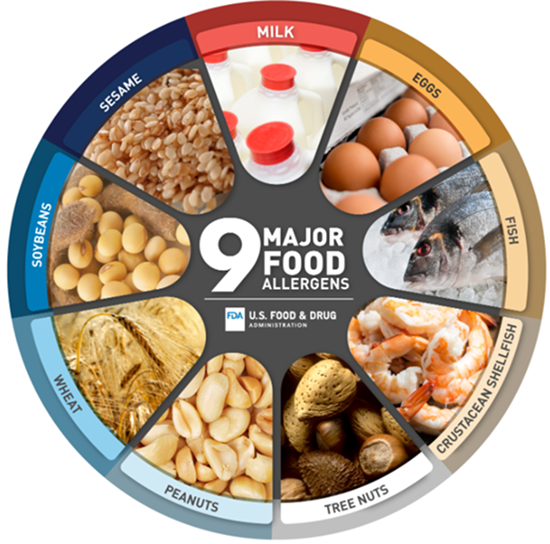Food allergens
Major food allergens
On Jan. 1, 2023, sesame became the ninth major food allergen in the U.S.
Allergen labeling is required for packaged food products that contain any of these ingredients.
Major food allergens must be identified by name in the ingredient list. This must include proteins derived from a major food allergen.
The nine major food allergens are:
- Crustacean shellfish
- Eggs
- Fish
- Milk
- Peanuts
- Sesame
- Soy
- Tree nuts
- Wheat
Food allergen training
We offer free food allergen training to food businesses in Minneapolis.
Learn more and request free voucher codes on our food handler training page
Food allergen safety tips
Tips for all staff
Prepare with care
Food workers play an important role in keeping customers will food allergies safe.
Take food allergies seriously.
Trace amounts of allergens can trigger an allergic reaction.
You should know:
- The 9 major food allergens
- Where to find the list of ingredients for all recipes
- How to prevent cross-contact with allergens
- Cooking does not kill allergens
Tips for back-of-house staff
Allergen free food order
- Pay extra attention to orders flagged for food allergies
- Wash hands and change gloves when preparing allergy-free meals
- Always use clean and sanitized food contact surfaces
- Follow safe food preparation procedures to avoid cross-contact with allergens
- Tell front-of-house team which dishes are allergen free for service to the table
- Give allergen free food items directly to server or to customer instead of setting the food item on the expo shelf
Returned food
- If a food item is returned to the kitchen for an allergen reason, always remake the item
- Do not try to remove an allergen and send the food back
Labeling and Storing
- Store all major food allergens separately in sealed and labeled containers
- Know the ingredients, including allergens, in garnishes, toppings, sauces, and dressings
Cooking food
- Update the ingredient list kept onsite when recipes change
Tips for front-of-house staff
Customer communication
- Listen carefully to customer requests. Repeat back the food allergy requests to the customer.
- Help customers in finding menu items that do not include certain allergens, or that can be made without allergens
- Answer customer questions about food allergens honestly. If you don’t know, don’t guess.
- Share cross-contact risks (if any) with customers who have food allergies
- Always let the customer make their own informed decision
Serving allergen free food
- Clearly communicate customer allergy information to the kitchen staff
- Take allergen-free orders to the table separately as soon as they are ready
- Follow your business’s food safety allergen plan on when to tell your manager about a customer’s food allergy questions
Tips for managers
Communicate effectively about allergens with customers
and staff.
Training
- Include allergies in your food safety plan.
- Assign a person to be responsible for your food allergen management plan
- Train staff on washing hands and changing gloves when preparing allergen-free foods
- Implement best practices to avoid cross-contact contamination including proper cleaning and sanitizing
- Train staff what to do if a customer has a severe allergic reaction during a meal
- Display food allergen signs, posters or flyers for staff
Menu items
- Keep onsite accurate recipes listing all ingredients
- Ask customers to tell their server if they have a food allergy.
- Provide allergen information for your customers. Consider putting it on your menu.
Labeling and Storage
- Accurately label all prepackaged foods for self-service with ingredients and major food allergens
- Store bulk ingredients with major food allergens separately from other foods
Labels
The label on a food package tells consumers exactly what is inside the package.
Keep labels
Businesses should keep the ingredient list from the label of food items purchased in a
- Package
- Bag
- Box
- Can
- Bottle
Examples: packaged buns from a bakery, boxed pasta, prepared sauces, etc.
Keep your recipes in a centralized location to be able to answer ingredient and allergen questions from your customers.
Label items you package
If you prepare and package food items for self-service, you must label the items.
Food is packaged if the food business:
- Bottles, cans, cartons, wraps or bags the product
- Makes the product available for self-service
Allergy labeling requirements
Apply to:
- Retail and food service businesses that package, label and offer products for human consumption
Does not apply to:
- Foods placed in a wrapper or container following a customer’s order at the point of purchase
Identify food allergens on your label by either:
- Listing the common or usual name of the food source, followed by the name of the allergen in parentheses. Examples:
- Flour (wheat)
- Whey (milk)
- After the ingredient list, place the word “Contains:” followed by the food allergen. Example:
- Contains: wheat, milk
Remember
- For tree nuts, declare the specific type of nut
Examples: almonds, coconut, pecans - For fish or crustacean shellfish, declare the species
Examples: walleye, shrimp, lobster
Resources
- Find our allergen resources for food workers in English and Spanish
- Read more on Food Labeling for Retail Food Establishments from the Minnesota Department of Agriculture
- Read more about food allergens from the Food and Drug Administration (FDA)
- Learn more about allergen labeling from the Food and Drug Administration (FDA)
Request accessible format
If you need help with this information, please email 311, or call 311 or 612-673-3000.
Please tell us what format you need. It will help us if you say what assistive technology you use.
Contact us
Environmental Health
Minneapolis Health Department
Phone
Address
Public Service Center505 Fourth Ave S, Room 520
Minneapolis, MN 55415


